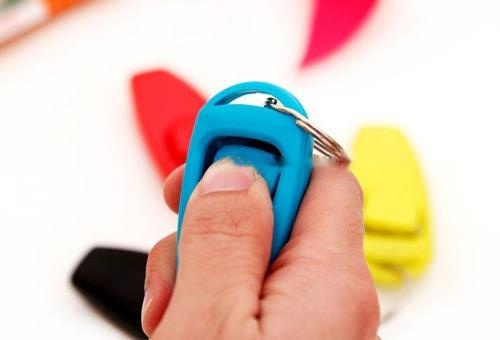What is a clicker? An animal training tool, usually the size of a matchbox, with a reed installed in it, which, when pressed, releases a crisp, short click sound. What is clicker training? Clickers use the clicker's rattle as a bridge between behavior and reward, with no scolding or punishment at all, to mark dog's behavior, gradually causing The natural reflex response allows dogs to make their own choices in pleasure, actively and accurately perform the behaviors we prompt to obtain rewards, and gradually, the bad behaviors without rewards will gradually disappear.

Suitable for age: 2 months-5 months
Training goal: Slice training is a way of training animals that uses conditioned reinforcement to signify (mark) that what the animal is doing at the moment is correct.
Applicable dog breeds: all breeds
Equipment: clickers|snacks|long leash|baton
Affiliated level: middle school (improvement)-sports Skill training
Training period: 15 minutes * 15 times
The first step: The method of clicker training: clicker There are three training methods, one is the induction method (Magnet), the other is the capture method (Capture), and the other is the shaping method (Shaping).
The induction method is fast but imprecise, which often leads to confusion or confusion. The capture method is more natural and accurate, but the initial training time is longer. In fact, the shaping method is to decompose the behavior or action to be trained into many approaching steps, and then use the capturing method to train and coherently approach the steps to achieve the behavior or action we want to train. Induction method (Magnet): Use treats to induce the dog to produce the behavior or action expected by the trainer. Once the dog does the right thing, press the clicker, and then give the treat reward.
Capture: Do not use any prompts such as snacks, gestures or sounds, and observe the dog's behavior or movements in detail. Once the dog has the behavior or movement expected by the trainer, immediately Press the clicker and a snack reward follows. Shaping: Do not use prompts such as snacks or gestures at all, observe the dog's behavior or movements in detail, and once the dog begins to respond to the behavior or movement expected by the dog owner, immediately press the clicker and follow it. Give a snack reward. It can also be said that the behavior or action expected by the trainer is decomposed into steps, each step is trained by the capture method, and the behavior or action expected by the dog owner is gradually achieved.
Step 2: C&T—This is short for Click and Treat, which means that when the dog shows the behavior we want, the clicker is pressed, and then immediately Give snacks.
Step 3: Generalization—this refers to generalization training, which is to repeat the training of the clickers many times in various environments or occasions to avoid dog Dogs are conditioned by their environment. The factors and quantities of interference must be gradually increased when selecting occasions and environments.
Step 4: Cue—We call it a cue. When the dog has repeatedly gone through the C&T to reinforce the behavior many times, a cue can be added before the C&T , the prompts can be verbal prompts (passwords) and gestures, gradually advancing the prompts before the behavior or action begins.
Step 5: Fading Clicker—Fading Clicker When the dog completes the correct behavior, first verbally say fading or Yes, then press the clicker and follow To give a snack reward, repeat the above steps and gradually reduce the clicker.
![[Dog Training 5] The training method of pet dog dining etiquette](/static/img/12192/12192_1.jpg)




